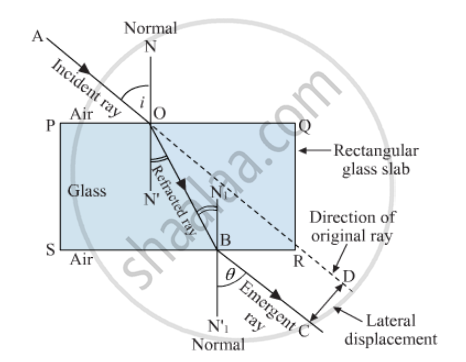Advertisements
Advertisements
प्रश्न
With the help of a diagram, show how when light falls obliquely on the side of a rectangular glass slab, the emergent ray is parallel to the incident ray.
उत्तर
In the following figure, a light ray travelling in air is incident on the rectangular glass slab. It gets refracted and bends towards the normal. Again, a change in the direction takes place when the refracted ray travelling in glass emerges into air. Here, the light ray bends away from the normal. We see that the incident and emergent rays are parallel to each other. These rays are parallel because the extent of bending on the opposite and parallel faces of slab is equal and opposite.

APPEARS IN
संबंधित प्रश्न
What are the important differences between looking at a photograph of your face and looking at yourself in a plane mirror?
A man stands 10 m in front of a large plane mirror. How far must the walk before he is 5 m away from his image?
State two effects caused by the refraction of light.
Name the phenomenon due to which a swimming pool appears less deep than it really is.
Light travels at a lower speed in water than in air.
Water is optically .......... than air.
We can see the sun even when it is little below the horizon because of ______.
Write scientific reason.
The sun appears on the western horizon for some time after sunset.
Observe the given figure and write appropriate phenomenon of light in the box.

Light bends as it passes from one medium to another. What is this phenomenon called?
